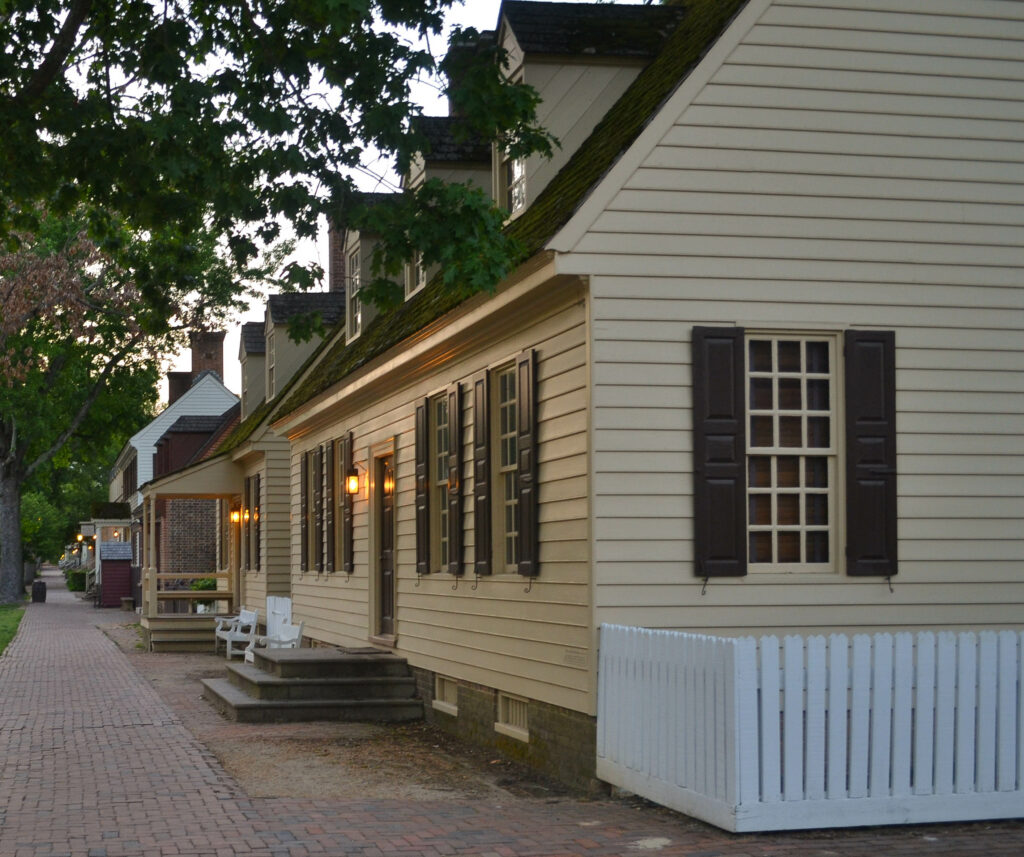Williamsburg, Virginia, is a history lover’s paradise. I visit the Commonwealth’s second capital several times a year.
Nestled in the Tidewater region, about 150 miles from Washington, D.C., the city is one point on Virginia’s Historic Triangle, between the York and James Rivers, and a fabulous base from which to explore other historic spots:
This post contains affiliate links. For more information, click here.
Jamestown
English settlers founded Jamestown in 1607 and named it for King James I, the son of Mary, Queen of Scots. It was the first lasting settlement after several failures, including Sir Walter Raleigh’s lost colony on Roanoke Island, now part of North Carolina. Jamestown served as Virginia’s first colonial capital during 1616-99. Today it’s another point on the Historic Triangle, seven miles from Williamsburg.
Visitors can join history and archaeology walking tours, learn about historic people and their trades, and explore what remains of James Fort at Historic Jamestowne.
Next door is Jamestown Settlement, a living-history museum that brings 17th-century Virginia to life. You may explore a colonial fort, a Powhatan Indian village, and replicas of three English ships that carried settlers across the Atlantic.
Yorktown
Visitors may explore Yorktown Battlefield, which is maintained by the National Park Service.
Nearby is the American Revolution Museum at Yorktown, which features a recreated Revolutionary-era farm and a Continental Army encampment.
Virginia Beach
Portsmouth
Its Olde Town historic district features centuries-old Federal and Greek Revival architecture, modern shops and restaurants, and a 1.5-mile park along its seawall.
Portsmouth is also home to the Rivers Casino, which offers live entertainment and a range of restaurants, as well as slots and table games.
Norfolk
The Chrysler Museum of Art hosts 50 galleries, including major collections of Impressionist paintings, neoclassical sculpture, and glass works.
The 155-acre Norfolk Botanical Garden features 60 gardens blooming with roses, magnolias, hydrangeas, and many other flowers. You may tour them on foot or by tram or boat in the warmer seasons.
Nauticus is a maritime discovery center that features interactive exhibits, aquaria, and the USS Wisconsin, the last battleship built in the United States, which served during World War II and the Korean and Gulf Wars.
The Virginia Zoo houses 700 animals, including big cats, red pandas, and lots of reptiles and amphibians.
Richmond
In 1775, Patrick Henry, Virginia’s first elected Governor, delivered his iconic “Give me liberty or give me death!” speech at St. John’s Church. Richmond replaced Williamsburg as Virginia’s capital in 1780. A year later, turncoat Benedict Arnold attacked the city, forcing Virginia’s second elected Governor, Thomas Jefferson, to flee first to Monticello and then to Poplar Forest.
Today, Richmond is the fourth-largest city in Virginia and hosts a number of museums.
The Virginia Museum of Fine Arts maintains a world-class collection ranging from pre-Columbian pottery to Fabergé eggs.
The Poe Museum houses the world’s largest collection of artifacts related to 19th-century genius Edgar Allan Poe, who lived in Richmond for a time.
The city’s 600-acre James River Park features more than 40 miles of trails, wildlife, rapids, forests, and spectacular views.
Carytown is a quirky neighborhood full of boutiques and bookstores, galleries and restaurants. Richmond is considered an up-and-coming Southern foodie city.
Hanover County
Hanover County sits north of Richmond, a little less than a 90-minute drive from Williamsburg. It was created in 1720 and named in honor of George I, the first British king from the House of Hanover, Germany. Its highlight is Scotchtown, residence of Patrick Henry, and one of the largest surviving 18th-century homes in America, which offers docent-led tours.
Fredericksburg
While geographically the South begins below the Mason-Dixon line between Maryland and Pennsylvania, culturally it begins in Fredericksburg, where life slows to a pleasant and polite pace. It’s primarily thought of as a Civil War city, but there is also a lot of colonial and Revolutionary history in Fredericksburg.
George Washington’s mother Mary lived here in a home that he purchased for her, and his brother Charles owned property that later became the Rising Sun Tavern; both are now museums.
The James Monroe Museum exhibits the desk on which the fifth president wrote the Doctrine that bears his name, a set of Louis XVI furniture from France, and jewelry belonging to his wife Elizabeth.
Chatham Manor links the history of the South from colonial times to the Civil War; it is located in the Fredericksburg & Spotsylvania National Military Park, which also includes the Fredericksburg, Chancellorsville, Wilderness, and Spotsylvania Court House battlefields.
Charlottesville
Just outside the city is Monticello, Jefferson’s magnificent mountain-top home. You may take a docent-led tour the house and wonder at the third president’s inventions, like the copy machine, the swivel chair, and the dumb waiter. You may also tour the gardens.
Also near Charlottesville is Highland, home of James Monroe, which too is open for tours and offers trails you may hike.
Orange County
From a temporary base in Williamsburg, you can explore American history and Virginia’s role in it from the 17th century on.
After my misspent youth as a wage worker, I’m having so much more fun as a blogger, helping other discerning travellers plan fun and fascinating journeys. Read more …

